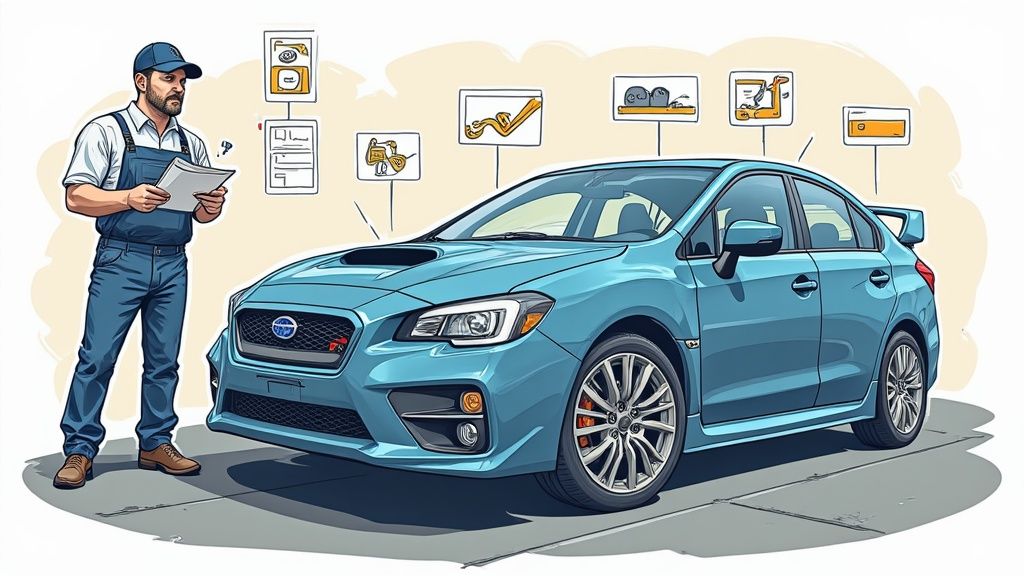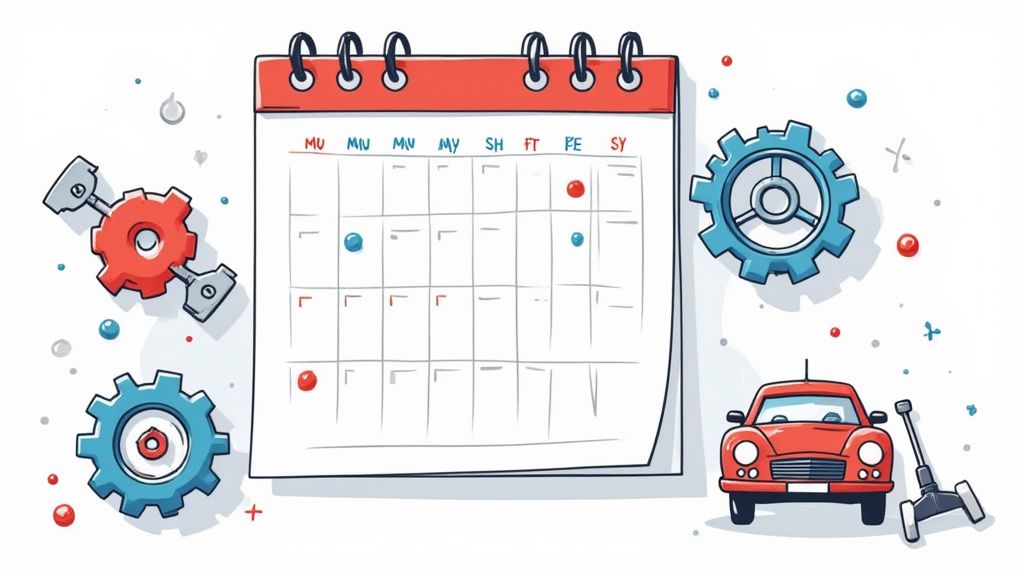
Ultimate Guide to Vehicle Maintenance Tracking: Transform Your Car's Performance and Value
Why Most Vehicle Owners Are Leaving Money on the Table

A well-maintained vehicle is a smart investment, but studies show that 72% of vehicle owners put off needed maintenance. This oversight has serious financial implications. Let’s examine why so many owners miss out on potential savings by neglecting proper maintenance tracking.
The Hidden Costs of Deferred Maintenance
Many owners see maintenance as an expense rather than an investment that saves money over time. Take oil changes - skipping this basic $50 service can lead to major engine issues requiring $5,000 or more in repairs. Similarly, putting off tire rotations causes uneven wear that shortens tire life and reduces fuel efficiency. These small maintenance decisions add up quickly, affecting both your wallet and vehicle longevity. The solution? Regular tracking of maintenance needs to prevent minor issues from becoming major repairs.
From Bare Minimum to Maintenance Maven: A Spectrum of Habits
Vehicle owners handle maintenance very differently. Some take a “bare minimum” approach, only addressing urgent problems. But this reactive strategy often results in bigger, more expensive repairs down the road. On the flip side, “maintenance mavens” understand the value of prevention. They carefully record every service - from oil changes to brake inspections - often using tools like Auto Service Logger to organize their records. This meticulous tracking helps maximize performance and resale value.
The Power of Proactive Tracking: Real-World Savings
The benefits of maintenance tracking are clear when you look at real examples. One owner who documented all maintenance in a simple spreadsheet earned $1,000 more when selling their car compared to similar vehicles with spotty records. The detailed service history gave buyers confidence in the car’s condition.
Another owner caught a slow tire leak during a routine check prompted by their tracking system. Finding this issue early prevented a potential highway blowout, avoiding not just tire replacement costs but also dangerous roadside repairs. These cases show how small changes in maintenance habits lead to real savings. By adopting similar tracking practices, you can protect your investment while ensuring safer, more reliable transportation. In the next section, we’ll explore how to create an effective maintenance tracking system for your vehicle.
Building Your Professional-Grade Maintenance System

After recognizing the value of tracking vehicle maintenance, you might wonder how professionals who manage large fleets keep everything running smoothly. The secret lies in creating an organized, systematic approach that goes beyond basic checklists. By adopting proven fleet management methods, you can develop a reliable system that works for your needs.
Key Components of a Professional System
Successful maintenance tracking relies on several essential elements working together effectively to ensure optimal vehicle performance and prevent issues from slipping through the cracks:
- Detailed Service Records: Documentation forms the foundation of any effective system. Record every service interaction, including dates, mileage readings, specific work performed, and the service provider’s name. These records become invaluable for tracking your vehicle’s history.
- Scheduled Maintenance Reminders: Stay ahead of potential problems with proactive maintenance alerts. Whether you prefer software notifications, calendar reminders, or physical notes, having a system prevents common oversights. For instance, studies by CARFAX show that 44% of owners skip tire rotations, while 29% fall behind on oil changes.
- Inspection Protocols: Regular checks help catch problems early. Create a routine that includes quick daily walkarounds and more thorough periodic inspections. Take photos during inspections to document conditions and track changes over time.
- Cost Tracking: Monitor all vehicle-related expenses, including maintenance, fuel, and insurance. This complete picture helps you make smart decisions about repairs versus replacement and identifies areas where you can reduce costs.
Adapting Professional Techniques for Personal Use
While fleet management involves more complexity than maintaining a single vehicle, the core principles remain relevant. You can scale down professional methods to fit your needs. For example, rather than using enterprise software, try a simple spreadsheet or a user-friendly app like Auto Service Logger to keep your records organized. For more specific guidance, check out our guide on how to master vehicle maintenance tracking.
Maintaining Consistency: The Key to Success
Creating a system is just the first step - the real challenge comes from following it consistently. Make vehicle maintenance a regular part of your routine with realistic goals you can stick to. Just as fleet managers track their maintenance completion rates, you can monitor how well you follow your own schedule. This disciplined approach pays off through reduced repair costs and increased vehicle longevity. Plus, according to CARFAX, detailed maintenance records can add hundreds of dollars to your car’s resale value compared to vehicles with spotty service histories. By following these proven strategies, you’ll develop habits that keep your vehicle running well for years while protecting your investment.
Mastering the Art of Vehicle Inspection

Regular maintenance keeps your vehicle running smoothly, but professional vehicle inspection takes maintenance to a new level. By checking your vehicle systematically and often, you can spot problems early and prevent breakdowns before they happen - saving time and expense down the road. Fleet managers use detailed inspection protocols to protect their investments, and you can apply these same proven methods to care for your personal vehicle. In this section, we’ll walk through the tools and techniques for effective vehicle inspections, whether you’re doing quick daily checks or more thorough evaluations. For more information, check out: How to master vehicle maintenance tracking and its importance.
The Importance of Routine Checks
Quick daily checks form your first defense against vehicle problems. Taking just a few minutes each day to inspect key components can reveal early warning signs before they become serious issues. Check tire pressure, fluid levels, and all lights to prevent problems like blowouts or visibility hazards. These brief inspections also help you become more familiar with how your vehicle normally looks, sounds and feels - making it easier to notice when something seems off.
Comprehensive Periodic Inspections
While daily checks catch obvious issues, deeper periodic inspections help identify developing problems that aren’t immediately visible. Schedule these detailed reviews monthly or quarterly, depending on how much you drive. Examine all major systems thoroughly - brakes, steering, suspension, exhaust and more. By dedicating time to systematic checks, you can find and fix small issues before they turn into major repairs.
Effective Documentation Techniques
Recording what you find during inspections is just as vital as doing the inspections themselves. Good documentation creates a clear history of your vehicle’s condition and maintenance needs over time. Use a simple checklist to ensure you don’t miss any inspection points. Take photos of components like tire tread and brake pads to track wear patterns visually. These records help you plan ahead for maintenance and catch developing problems early.
Real-World Examples: Inspections That Saved the Day
The value of thorough inspections becomes clear through real examples. One car owner used a basic checklist and photos during quarterly inspections and noticed uneven tire wear developing. By catching this early, they were able to rotate the tires and align the wheels before the tires were ruined or steering was affected. Another owner found a small oil leak during a routine check, preventing what could have led to serious engine damage. Stories like these show how consistent inspection and documentation protects vehicles and saves money. By applying these proven inspection methods, you’ll gain a much better understanding of your vehicle’s condition and needs over time.
Leveraging Maintenance Records for Maximum Resale Value

Good vehicle maintenance records do more than just track service history - they can significantly boost your car’s resale value. Just as detailed home maintenance records increase property value, a well-documented vehicle service history makes your car more appealing to buyers and helps justify a higher asking price. Taking time to maintain thorough records today directly impacts what you’ll get for your car when it’s time to sell.
What Buyers Look For: Proof of Proper Care
When shopping for a used car, buyers want clear evidence that the vehicle has been properly maintained. Simply stating “I took good care of it” isn’t enough - they need documented proof. A detailed service logbook showing regular oil changes, tire rotations, and preventive maintenance provides that validation. Records of major work like brake jobs or transmission repairs also demonstrate transparency and build trust with potential buyers. For more insights, check out: How to master the art of increasing the resale value of your vehicle with proper maintenance tracking.
Building a Compelling Maintenance History
Good maintenance records require more than just collecting receipts. You need an organized system to track all service work. Whether you use a paper logbook or digital tools like Auto Service Logger, staying systematic is key.
Here’s what makes maintenance records valuable:
- Consistency Is Key: Document all maintenance, even minor services, to show ongoing care
- Details Matter: Note the date, mileage, service type, and provider for each maintenance visit
- Supporting Documents: Keep receipts, invoices and photos to back up your service claims
- Highlight Value-Adding Services: Document premium services like synthetic oil use or early preventive maintenance
Showcasing Your Records Effectively
When selling your car, present maintenance records in an organized, professional way. Think of your service history as proof of your car’s excellent care. A neat logbook or printed report from a digital service platform makes a strong impression on buyers. Complete records also help answer questions up front, building buyer confidence and supporting your asking price.
Real-World Impact: Turning Records Into Returns
The financial benefits of good maintenance records are clear. According to CARFAX, vehicles with complete service histories can sell for up to $330 more than similar cars lacking documentation. Consider two identical used cars - one with scattered receipts, another with organized records showing every oil change and repair. The car with detailed records naturally appeals more to buyers and commands a better price. Even documenting basic services like oil changes and tire rotations adds perceived value. By maintaining thorough service records, you’re actively protecting and increasing your car’s future worth.
Implementing Professional Cost Analysis Systems
A strong vehicle maintenance tracking system requires careful attention to financial management. Much like how businesses track their expenses in detail, establishing a solid cost analysis system helps make better decisions about maintenance, repairs, and long-term vehicle ownership. By taking a structured approach to tracking costs, you can optimize your spending and make informed choices.
Understanding Total Cost of Ownership (TCO)
When owning a vehicle, the purchase price is just the beginning. Total cost of ownership includes ongoing expenses like fuel, repairs, insurance, depreciation, and fees. A lower-priced vehicle might seem affordable initially, but factors like high insurance rates or poor fuel economy could make it more expensive in the long run compared to a pricier model with lower operating costs. Understanding the complete TCO picture is essential for making smart vehicle decisions.
Building Your Cost Analysis System
To track costs effectively, start by setting up a dedicated spreadsheet or using specialized tools like Auto Service Logger. Break down your expenses into key categories:
- Fuel: Document each fill-up with the date, mileage, gallons, and cost per gallon. This helps spot changes in fuel efficiency that could signal maintenance needs.
- Maintenance: Record all routine services including date, mileage, work performed, and cost. This history helps predict future maintenance needs and plan your budget.
- Repairs: Note any unexpected repairs, capturing the date, mileage, issue details, and repair cost. Looking at repair patterns can reveal if ongoing problems need a permanent fix.
- Other Expenses: Keep track of insurance, registration, parking fees, and miscellaneous costs. This gives you a full view of what your vehicle truly costs to own.
Utilizing Data for Informed Decisions
Regular tracking allows you to spot trends and make better choices. For example, a sudden drop in fuel economy might point to a maintenance issue that needs attention. By analyzing repair costs over time, you can determine whether fixing an expensive problem makes sense or if replacement is smarter financially. Detailed maintenance records can also increase your vehicle’s resale value by showing responsible ownership.
Example: Repair vs. Replace
Consider this scenario: Your car needs a $2,000 transmission repair. Looking at your tracked expenses shows significant repair costs over the past year on a vehicle worth only $3,000. Your cost analysis reveals that investing in another major repair may not be financially sound compared to putting that money toward a more reliable vehicle. This shows how methodical cost tracking helps guide smart spending decisions rather than reactive repairs.
Creating Your Customized Maintenance Strategy
A well-planned maintenance system is essential for keeping your vehicle running smoothly. But what really matters is developing a personalized approach that fits your specific situation and vehicle needs. Here’s how to build a maintenance strategy that works for you.
Defining Your Vehicle’s Specific Needs
Each vehicle has unique maintenance requirements based on key factors like make, model, age, and typical usage patterns. For instance, if you use your truck for daily deliveries with heavy loads, it needs more frequent maintenance than a car used mainly for weekend trips. Start by checking your owner’s manual for the recommended service schedule, then adjust it based on your driving conditions. Frequent towing or driving in extreme weather may require more regular oil changes and inspections.
Choosing the Right Tracking Tools
After understanding your vehicle’s needs, select tracking tools that match your style. A basic spreadsheet works well for logging services and expenses, while specialized apps like Auto Service Logger offer advanced features such as automated reminders and mileage tracking. Many apps also let you store digital copies of receipts and service records, giving you a complete maintenance history in one place.
Setting Up Effective Reminder Systems
Even with the best intentions, it’s easy to forget scheduled maintenance. The key is finding a reminder system that naturally fits into your routine. If you’re always on your phone, use calendar alerts or maintenance apps. For those who prefer visual cues, try dashboard sticky notes or a dedicated maintenance calendar. Pick a method you know you’ll actually use - this helps ensure you stay on schedule and catch potential issues early.
Adapting Your System Over Time
As your vehicle ages and your driving habits change, your maintenance needs will shift too. An older vehicle might need more frequent service, while a new commute pattern could affect your maintenance timing. Review your strategy periodically to make sure it still matches your current situation. Think of your maintenance plan as something that grows and changes along with your vehicle’s needs.
A consistent maintenance strategy, built around your specific needs, helps maximize your vehicle’s performance and value over time. By creating a system that works for you, regular maintenance becomes less of a chore and more of an investment in your vehicle’s future.
Ready to take control of your vehicle maintenance and start seeing the benefits of a well-maintained vehicle? Start tracking your maintenance today with Auto Service Logger!